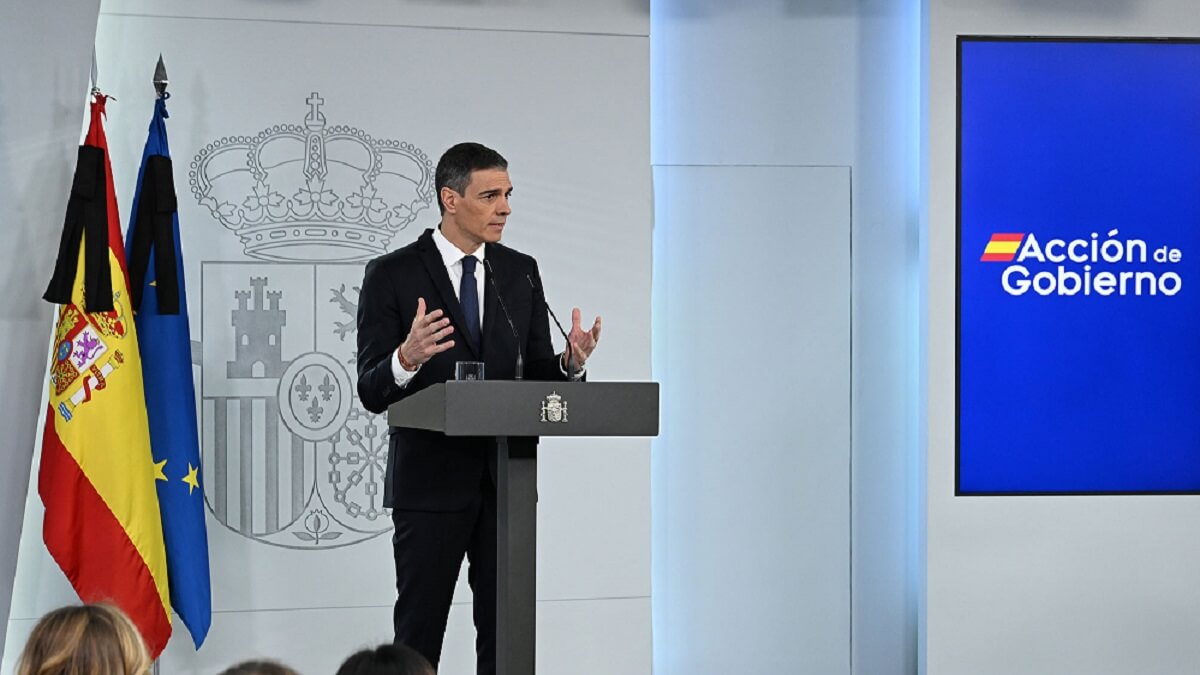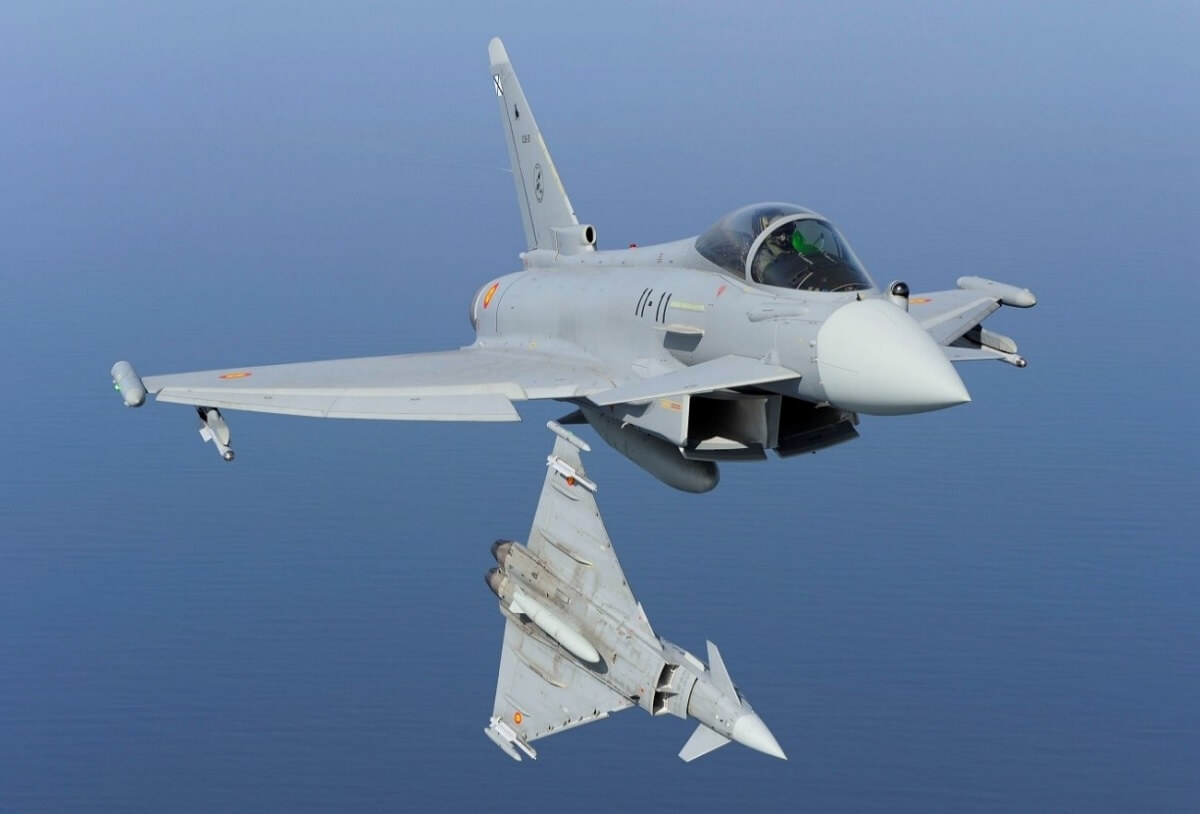Sánchez complies with the 2% defence spending target with an additional 10.47 billion euros

It took President Sánchez less than 30 days to rename the initial Grand National Plan for the Development and Promotion of Spanish Security and Defence Technology and Industry, which he spoke about before the plenary session of Congress on 26 March.
The proposal with which Sánchez aims to meet the demands imposed on him by Ursula von der Leyen and NATO Secretary General Mark Rutte in Brussels by 2025 has just been unveiled ‘urbi et orbi’ under the pompous name of Industrial and Technological Plan for the Security and Defence of Spain and Europe. But he did so boldly, without seeking approval from Congress or the support of his government allies.
What does the Industrial and Technological Plan include? In a 38-minute appearance at the Moncloa Palace, the head of the executive branch gave a few details about its content and economic volume, with which he assures that Spain will ‘jump from 1.4% of GDP in security and defence investment in 2024 to 2 % in 2025’. The document is a ‘rehash’ by the director of Economic Affairs of the Presidency, Manuel de la Rocha, based on contributions from the Defence Staff and the Ministries of Industry and Science.

In order to obtain NATO approval, which has very clear rules on what is considered expenditure or investment in defence, the Council of Ministers has agreed to allocate a ‘significant’ investment of 10,471.14 million euros ‘in addition’ to the Ministry of Defence's existing budget. But ‘without raising taxes, without touching a single cent of investment in the welfare state and without incurring a higher public deficit,’ Pedro Sánchez stressed. And, in addition, in the eight months remaining this year, ‘to execute the entire budget allocation for the Plan’.
The head of government has announced that his Plan will be sent to Brussels today, Wednesday 23 April, so that its ‘technical and budgetary foundations can be evaluated by NATO and the European Union’. If it receives the green light, the president will be able to present the as yet unknown details to Congress and boast of ‘consolidating’ Spain as a ‘central and reliable member of the EU and the Alliance’, a mantra repeated ad nauseam by both Sánchez and his defence minister, Margarita Robles.
The president has emphasised at the Moncloa that 81.25 per cent of the economic volume of his plan is earmarked for items ‘not related to armaments’. It is therefore possible that his initiatives will meet with serious objections in Brussels and that the so-called ‘new wave of innovation and reindustrialisation around dual-purpose technologies’ will suffer a setback that will require its modification.

The five pillars of Sánchez's plan
The Spanish version of the ReArm Europe Plan is based on what the president himself has described as ‘five main pillars’. The first and most important pillar accounts for 35.45% of the total investment and allocates 3,712.49 billion euros to ‘improving the working conditions of troops and sailors, increasing their numbers, their training and their equipment’.
The second set of actions is aimed at ‘manufacturing and acquiring new telecommunications and cybersecurity capabilities’. It amounts to 3,262.76 million euros, representing 31.16 per cent of the total investment, and seeks to ‘modernise the Armed Forces’ encrypted communications systems with the purchase of new satellites, antennas and radars'.
It is not clear whether the second section includes the two new Paz 2 spy satellites and the Spainsat NG secure communications satellites, the first of which has been in orbit since the beginning of the year. What is included are measures to strengthen civil and military cybersecurity tools in the cloud, 5G technologies, artificial intelligence and quantum computing ‘to create a digital shield against foreign hackers’.

The third pillar accounts for 18.75 per cent of the total investment. This amounts to 1,962.98 billion euros, which will be allocated to ‘the manufacture and purchase of new defence and deterrence equipment’, a euphemism for the purchase of missiles, new weapons systems and advanced land, air and naval combat platforms.
The fourth pillar on which Sánchez's proposal to Brussels is based accounts for 16.73% of the total investment. This amounts to 1,751.53 billion euros and is earmarked for ‘strengthening the dual capabilities of our Armed Forces’, but so that they ‘can also help in emergency and natural disaster management’, the president pointed out.

Rearming with a hydrographic vessel
According to Sánchez, with the 1.75 billion, Spain will expand its fleet of helicopters... ‘for rescue and logistical support, acquire new bridge-launching vehicles, tanker aircraft for firefighting (?), charter a new hydrographic vessel and modernise the defence infrastructure that must respond to emergency situations affecting national security’.
The fifth and final chapter focuses on ‘improving the security conditions’ of the nearly 3,000 military and civil guards who make up the 16 missions that Spain carries out abroad under the flag of the UN, the EU or NATO. Their work will receive 328.74 million, 3.14 per cent of the total.

Where will the 10.471 billion allocated to the Plan come from? Sánchez pointed this out in his speech and reiterated it during the question and answer session. Firstly, from ‘reallocating more than 1.3 billion euros from certain items in the PERTE, including those earmarked for cybersecurity’. Also from the ‘savings generated by the rigorous management of the government's economic policy’, he said, and from ‘certain items in the 2023 General Budget that are no longer needed’.
The president has promised that ‘most of the money we are going to mobilise will remain in Spain’. He specified that his estimate is that ‘87% of the investment’, around €9 billion, ‘will go to Spanish companies and workers in a wide range of sectors and in all the autonomous communities of the country’.

He announced that the funds will be directed towards the ‘industrial corridors for security and defence that already exist in the north, south, east and west of Spain’, areas which, he assured, ‘we are going to extend to new territories, so that companies can increase their activity, their workforce and modernise their production systems’. He said that ‘less than 5 per cent of the investment’ will be allocated to the purchase of ‘spare parts or essential components’ that are not currently produced in Europe. In other words, around €520 million will be spent on purchases outside the EU.
Pedro Sánchez also indicated that the government estimates that the Plan will ‘increase national GDP by between 0.4 and 0.7’, that it will increase research and development ‘by almost 18%’ and that it will ‘create around 100,000 jobs, 36,000 direct and around 60,000 indirect jobs... most of them with higher than average skill levels and salaries in our country’. Given this statement, one wonders why a plan with so many advantages has not been implemented before.












